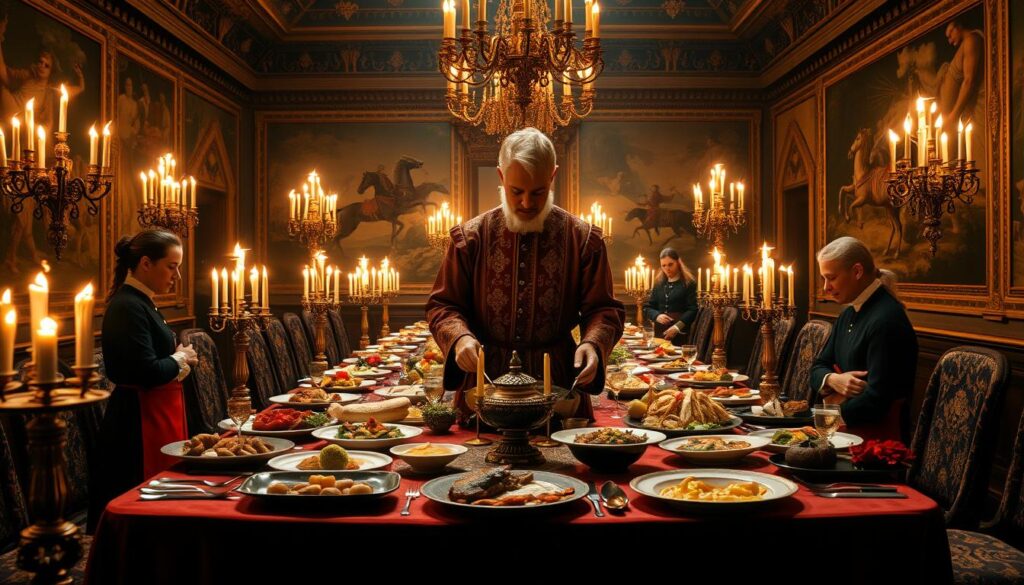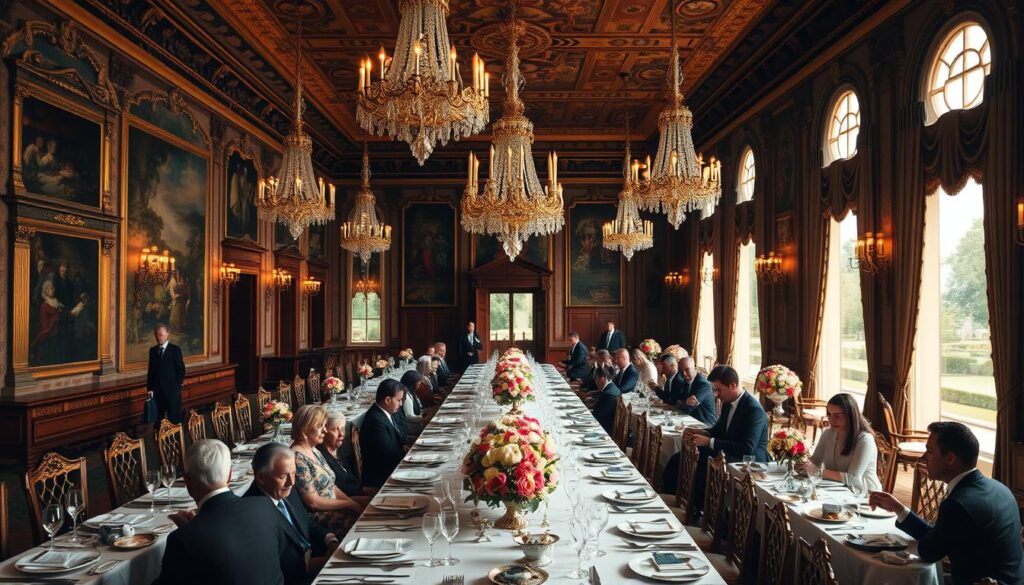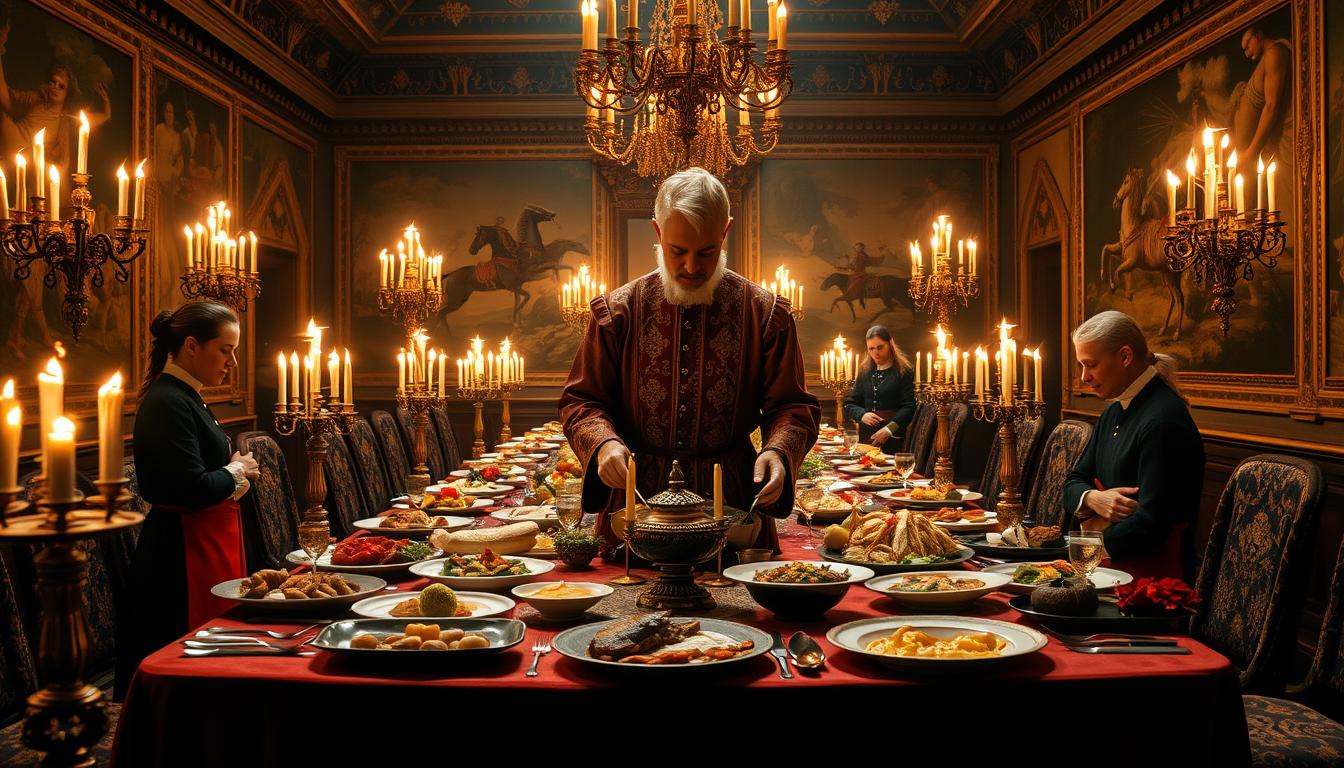Exploring the world of royal food tasting shows us a unique job. It’s all about making sure the food for the monarch is safe and top-notch. This role is key in the royal household. Every step, from checking ingredients to cooking, is done with care to keep the monarch safe and happy.

Introduction to Royal Food Tasting
Royal food tasting is an art that has grown over time. Food tasters for royalty are essential for the monarch’s health. This job is complex, with a big cultural impact. We’ll dive into the history, modern role, and traditions of royal food tasting.
Key Takeaways
- Royal food tasting is a unique profession that requires great attention to detail.
- A food taster for royalty must evaluate every dish served to the monarch.
- Royal food tasting involves ensuring the safety and quality of the food.
- The process of royal food tasting is meticulous, from ingredients to cooking methods.
- Royal food tasters play a vital role in maintaining the health and well-being of the monarch.
- The cultural impact of royal food tasting is significant, with a rich history and tradition.
- Royal food tasting is an art that has been perfected over the years, with a focus on quality and safety.
What is a Food Taster for Royalty?
The role of a food taster for royalty is both unique and fascinating. It has been a part of monarchy cuisine for centuries. In the past, these tasters checked the food for the monarch to avoid poisoning.
This tradition goes back to ancient times. Monarchs used historical food tasters to keep themselves safe.
Today, the job of a food taster has grown. They now check the quality of ingredients and how dishes are presented. These tasters are experts in monarchy cuisine and food safety.
Some key tasks of a royal food taster include:
- Evaluating the quality and freshness of ingredients
- Testing food for taste, texture, and presentation
- Ensuring that food is prepared and served safely
- Developing and implementing food safety protocols
Royal food tasters also need great communication and people skills. They work with chefs, food suppliers, and others in the royal household. Their knowledge of historical food tasters and monarchy cuisine is crucial. They help keep the monarch and their guests safe and healthy.
The Historical Significance of Royal Food Tasters
Royal food tasters have been key in keeping monarchs safe from poisoning. They use food safety protocols to spot dangers. Their job is to make sure the food for the monarch is safe and of high quality.
Some of the main tasks of a royal food taster include:
- Tasting food and drinks before they are served to the monarch
- Inspecting food for signs of tampering or contamination
- Overseeing the preparation and handling of food
Thanks to these efforts, many cases of poisoning have been prevented. This shows how vital food safety protocols and food security measures are. They have been crucial in the history of royal food tasters.
A Day in the Life of a Royal Food Taster
A royal food taster’s day is packed with tasks. They check the quality of ingredients and ensure food safety for the monarch. Modern food tasters are key in keeping food standards high. They make sure every dish is tasty and safe.
The day starts with reviewing the menu and checking ingredients. They look for spoilage or contamination.
They follow strict tasting rules. This includes tasting a small part of each dish before serving. They check for unusual flavors or textures that might mean contamination. They also know a lot about different cuisines and ingredients, and potential allergens or safety risks.
Some of the key tasks of a royal food taster include:
- Conducting regular inspections of the kitchen and food storage areas
- Monitoring food temperatures and handling practices
- Maintaining detailed records of food purchases and inventory
Modern food tasters use their knowledge of food safety and quality control. They ensure the monarch and their guests have safe and delicious meals. Whether it’s a state dinner or a private luncheon, they play a crucial role in the royal household’s standards.
Training and Qualifications Required
To become a royal food taster, you need certain skills and qualifications. These include culinary training and knowledge of food safety. Royal dining demands a deep understanding of culinary traditions and the ability to spot health threats.
A royal food taster must have a solid base in the culinary arts. They also need to know about food quality control and safety. This ensures the royal family’s health is protected.
A typical training for a royal food taster includes courses in food science, nutrition, and culinary arts. Key qualifications include:
- Knowledge of food safety protocols and regulations
- Understanding of culinary traditions and royal dining etiquette
- Ability to identify potential foodborne illnesses and contaminants
- Strong communication and documentation skills
During their training, royal food tasters may attend workshops and seminars. These cover topics like food allergy awareness and culinary trends. This mix of theory and practice helps them develop the skills needed to ensure the royal family’s meals are safe and of high quality.
In the world of royal dining, culinary traditions are crucial. They shape the dining experience from ingredient selection to dish presentation. Every detail is considered to make sure the royal family enjoys a safe and pleasant meal. By respecting these traditions, royal food tasters support the royal household and uphold culinary excellence.
Famous Food Tasters Throughout History
Food tasters have been key in history, from stopping poisonings to shaping food traditions. In monarchies, they made sure the ruler’s food was safe. We’ll look at famous food tasters, their roles, and how they changed food history.
In medieval Europe, royal food tasters were crucial. They tasted food and drinks before the king. These royal food tasters were experts at finding poison or bad food. In Asian dynasties, food tasters were also important, sometimes becoming very powerful.
Today, tasters keep the tradition alive. Some have become famous for their work in royal food tasting. They’ve introduced new foods and ways of cooking that we enjoy today. By learning about these tasters, we see how vital they are to food history.
- Medieval European court tasters were known for their skill and bravery in detecting poison and contamination.
- Asian dynasty food tasters were highly valued for their ability to detect subtle flavors and textures.
- Notable modern-era tasters have continued to shape the course of culinary history, introducing new ingredients and techniques.
These famous food tasters have made sure rulers enjoyed safe food. They’ve also helped create new food traditions and methods. Their work still influences food today, with royal food tasting still important in many places.
The Science Behind Food Tasting for Royalty
Food tasting for royalty is a complex and fascinating topic. It involves many factors, like the chemistry of taste and the psychology of perception. Food safety protocols are key to ensuring the quality and safety of the food. These protocols help prevent contamination and foodborne illnesses, which are crucial in the tasting process.
Food security measures are also vital in royal food tasting. They ensure the food served is genuine and untampered with. This requires careful attention and a deep understanding of the food.
Some key aspects of the science behind food tasting for royalty include:
- Chemistry of taste: understanding how different chemicals in food interact with our taste buds
- Psychology of perception: understanding how our brains process and interpret sensory information
- Food safety protocols: preventing contamination and foodborne illnesses
- Food security measures: ensuring the authenticity and integrity of the food being served

Understanding the science behind food tasting for royalty shows its complexity and nuance. It requires a deep grasp of food safety and security, along with a keen sense of taste and smell. Whether you’re a royal food taster or just a food enthusiast, the science behind food tasting is sure to fascinate and delight.
Modern Security Measures and Food Safety Protocols
Keeping the food safe for the monarch is a big deal for modern food tasters. They do lots of things, like testing food and planning for emergencies. Thanks to technology, food quality control is now better and faster.
Modern food tasters use the latest tech to find and stop food safety risks. They use labs, taste tests, and more to make sure food is safe and good. They also make sure food is handled right and that everyone knows how to keep it safe.
- Regular food testing and analysis
- Implementation of proper food handling and storage procedures
- Training of food handlers on food safety protocols
- Establishment of emergency response plans in case of food safety incidents
These steps help make sure the monarch gets safe, quality food. And they let modern food tasters do their jobs well.
Cultural Impact and Royal Traditions
Royal dining has shaped culinary traditions worldwide. From European monarchs’ lavish feasts to Asian dynasties’ complex dishes, royal food tasters have played a key role. Their expertise has refined and perfected many dishes.
The influence of royal food tasters is clear in royal dining traditions. These traditions, passed down through generations, are vital to royal culture. Examples include:
- Formal state dinners, where monarchs entertain foreign guests and showcase their cuisine
- Traditional holiday meals, like Christmas or Thanksgiving, with specific dishes and rules
- Ceremonial feasts for special events, such as coronations or weddings

In summary, royal food tasters have greatly influenced culinary traditions. Their impact goes beyond palaces, shaping how we enjoy and appreciate food today.
Conclusion: The Evolving Role of Royal Food Tasters in Contemporary Monarchy
The world of food is always changing, and so is the job of royal food tasters. They used to be very important, making sure the king or queen was safe to eat. Now, they face new challenges with better food safety rules and changing tastes in royal homes.
Today, royal food tasting is a mix of old traditions and new ways. They still check the food’s quality, taste, and safety. But now, they use new tools and technologies to do their job.
These tasters need many skills, like knowing a lot about food and being good at science and handling emergencies. As food trends keep changing, these royal kitchen heroes will be more important than ever. They will help keep the monarchy healthy, safe, and delicious.
FAQ
What is the historical significance of royal food tasters?
Royal food tasters have been crucial in history. They helped prevent poisoning and kept monarchs safe. Their role has stayed the same, checking food quality and safety for the monarch.
What are the key responsibilities and duties of a royal food taster?
Food tasters check every dish carefully. They know a lot about food, safety, and cooking. This ensures the food is safe and of high quality for the monarch.
What kind of training and qualifications are required to become a royal food taster?
Becoming a royal food taster is tough. You need culinary training and to know about food safety. It’s all about understanding food, traditions, and quality control.
What is the science behind food tasting for royalty?
Food tasting for royalty involves complex science. It’s about taste chemistry and perception psychology. Tasters need to know this to judge food quality and safety.
What are the modern security measures and food safety protocols for royal food tasters?
Today, food tasters use advanced tech and procedures. This includes food testing and emergency plans. These steps are key to keeping the monarch’s food safe and good.
How have royal food tasters impacted culinary traditions and the development of cuisine?
Royal food tasters have greatly influenced food traditions and cuisine. They’ve shaped national cuisines and helped cuisine grow. Their work is vital in the culinary world.
